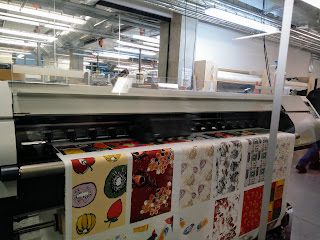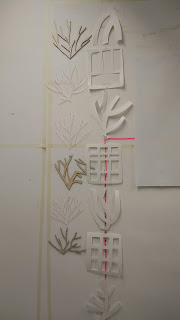Unit x - Reflection
This unit has taught me that communication is key to developing
ideas. Whether that be through swapping samples, going on research trips as a
group, or simply sharing ideas. By talking through thoughts with other people I
have been more open to taking risks. Allowing my printed samples to be added to
a weave showed me that what I considered to be a finished piece could in fact be re-purposed multiple times. I am now more aware of the lifespan of textiles
pieces and the way a sample or even final piece can keep on providing
inspiration. Having people to talk to about the direction of work was one of my
favourite things about the unit. Often I become very introspective about my
work, getting bogged down and not feeling able to explain it to others. Constantly
meeting up with my group to evaluate was hugely beneficial to me and made me enthusiastic
about coming up with lots of ideas to then talk about at the next meeting.
I found the research
stage of the project thoroughly engaging. Visiting the Museum of Science and Industry
as a group meant we all had a clear vision of the theme. I think that as we
chose a wide-ranging topic and there was such a lot of material, I found it
difficult to focus on one or two aspects to research in depth. Later, in the
project I chose to look specifically at hands, but in the initial stages tried
to incorporate too many themes, such as technology that keeps us safe, the
developments of technology over time and the future of creative jobs, all
weighty topics in their own right. I was keen to get sampling in the print room
as soon as possible, and produced lots of samples using some unusual fabrics,
however I think this could have been developed much further. Working onto weave
and knit samples worked well and contributed to the progression of the group’s
work with a focus on foiling and embroidery. Being more confident with using
interesting grounds is something I need to build on in future and I will spend
more time during the research stages of my next projects collecting materials.
In terms of research I think this was conducted well and in
enough depth to provide a solid starting point for the project. Although I found
it difficult to isolate themes, having varied initial research meant that this
could feed into later developments. Examples of this include some of the
drawings I did from my study of technology in the city centre cropping up as
motifs within my development of hands. Towards the end of the project I embellished
onto some of my samples and worked into them with the tufting machine, as well
as using eyelets to reference earlier circuit board shapes. I feel that I could
have taken these techniques much further if I had had the confidence to move
out of the familiarity of the print room and experiment.
As a group, we met regularly to have feedback sessions and
evaluate everyone’s samples up to that point. The most effective part of these
meetings was the creation of storyboards. These included photocopies of
sketchbook pages and samples and helped us visualise how our work fitted
together as a collaborative effort. This benefited the colour mood of the group
and meant that our final collection of samples was cohesive and fluent.
The most important thing I have learnt is that, even if you aren’t
directly working as a group, collaborating with people is necessary to offer an
outside perspective and advice on how to progress. Collaborating has also made
me more conscious of deadlines and the need to keep on top of workloads. Rather
than producing as much work as possible, I will try to take on advice from
others in future to make more considered outcomes. I enjoy print a lot so was
reluctant to venture into other areas such as knit. Having spent time
embellishing my work in embroidery, I am more sure that I prefer printed
surface design and now want to work on
creating exciting printed designs on unusual and interesting fabrics to
introduce texture.
 |
| One of our group story boards. |
 |
| Our final samples on display. |


Comments
Post a Comment